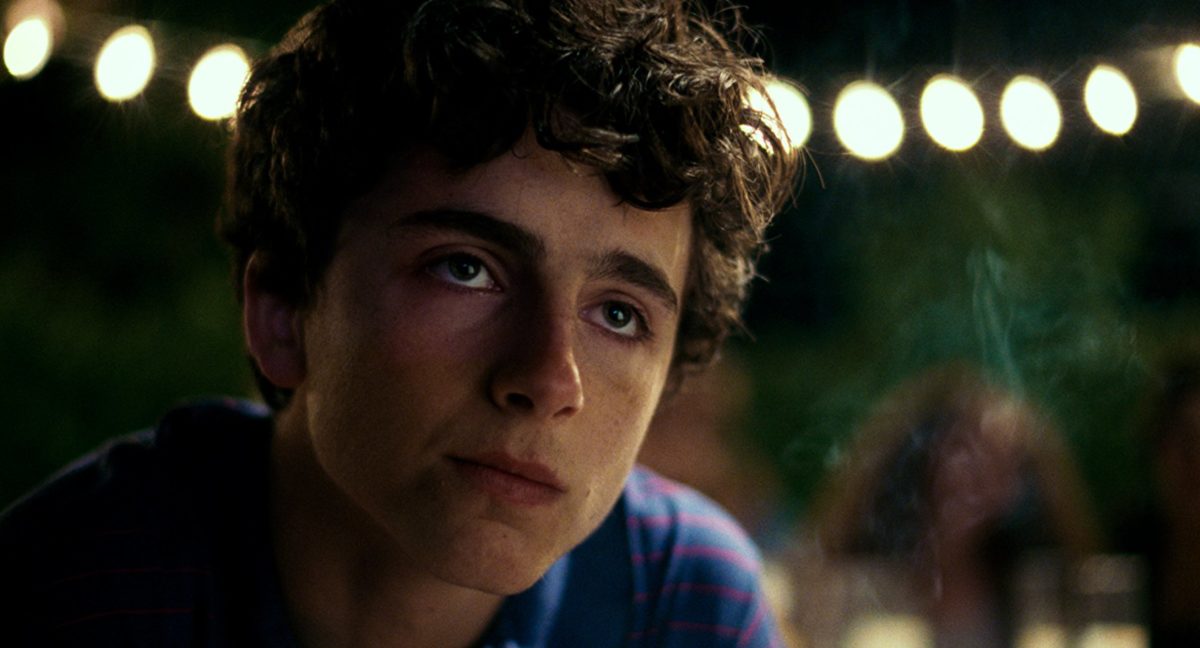Right upon the start of its traverse through the international film festival circuit, when it premiered at Sundance, Call Me By Your Name (Luca Guadagnino, 2017) was received with almost undiluted levels of critical acclaim. This adaptation of André Aciman’s homonymous 2007 novel about the romantic relationship established during a hot Italian summer between Elio (Timothée Chalamet), the precocious son of an American professor (Michael Stuhlbarg), and his father’s academic protégée, Oliver (Armie Hammer), seemed to be instantaneously welcomed as a new masterpiece of queer cinema, right on the trail of Moonlight (Barry Jenkins, 2016).
At that time, the aforementioned 89th Best Picture Oscar winner hadn’t yet been named so, and, to many people, the prospect of its victory seemed rather unlikely. After all, even if its small budget, formalistic discourse and focus on a marginalized ethnic minority were to be ignored, Moonlight would still be a queer film, anathema to the concept of an easily consumed, politically passive and socially conventional work that’s popularly associated with that award. Brokeback Mountain (Ang Lee, 2005) was, after all, the absolute favorite to win the Best Picture Oscar in its year, but it lost in what many justifiably called a manifestation of Hollywood’s reluctance to completely embrace queer stories. Even in film festivals, queer themed films tend to be recognized separately from non-queer themed ones, with such honors as the Teddy at Berlin or the Queer Palm at Cannes. Queer cinema is niche, it’s not mainstream, it’s not what’s supposed to win Best Picture Oscars, yet Moonlight did.
Because of that, we must contend with the fact that Call Me By Your Name is being released into a post-Moonlight world, one where extensive award campaigns and promotional tours are already in motion, at the moment of this writing, for the kind of film that would probably be struggling to get wide international distribution as recently as ten years ago. As western queer culture slowly inches its way into the mainstream, the attention paid to it is becoming more widespread than ever before. Call Me By Your Name has benefited from this phenomenon, but its positioning at the edges of mainstream has also made it carry the burden of representability. The casting of straight actors in the roles of queer men and its main characters’ conventionally masculine gender identity, as well as their class and economic affluence, have been criticized as the latest examples of bigger issues in the panorama of queer cinema. Still, none of the film’s queer elements has been more scrutinized or negatively criticized than its sex scenes and conspicuous absence of explicit male nudity.
The Problem of Looking Away
Regarding the first point of contention in this debate, it’s important to understand that there’s an undeniable difference in the way the film depicts Elio’s heterosexual sex scenes with his friend Marzia (Esther Garrel) compared to the consummation of his sexual and emotional attachment to Oliver. The first time Elio and his female companion have sex, Guadagnino adopts a physically superior point of view, looking down on his actors’ mostly clothed bodies. He unashamedly lets the audience perceive the motions of thrusting and the bodily spasms of a premature ejaculation. Later, on the second scene of this ilk, DP Sayombhu Mukdeeprom presents the actors’ bodies bathed in soft warm light and shoots the landscapes of naked flesh, which include Garrel’s exposed breasts, with unabashed eroticism.
When Elio and Oliver finally have sex, the scene’s construction is pointedly different from that of those sexual encounters with Marzia. For one, there’s a multiplicity of tone, a byproduct of the scene’s longer duration and of the characters’ more complicated relationship. Instead of moving at an assured pace through an unchanging tonal register, Guadagnino allows small pockets of comedy and awkwardness to play as interlude between more forwardly seductive stances. He also uses close-ups of isolated body parts to suggest a more purely carnal connection, before returning to medium shots where the play of expression and reaction in the actors’ faces takes us to a realm of tentative intimacy.
Still, those aren’t the elements of the scene numerous audience members are having problems with. The issues manifest when one realizes that, despite the fact Call Me By Your Name’s screen adaptation goes so far as to include Elio’s father pontificating on the desirability of classical bronze sculptures of nubile young men, the most we see of the protagonists’ naked bodies is restricted to what they reveal when wearing bathing suits or a very rare flash of bare buttocks. Furthermore, before the sex scene could even insinuate the direct touch of genitalia, Guadagnino abruptly pans to the right, forcing the audience’s gaze to detach from the bodies erupting in desire to focus on the foliage of a nearby tree.
Some critics, like Guy Lodge for The Guardian, have accused the film of being coy, going so far as to wonder if this is a compromise that endorses the idea that gay cinema must be sexless to succeed. Rich Juzwiak wrote, for Jezebel, that, thanks to these compromises and possible manifestations of sexual shame, Call Me By Your Name is the most mainstream user-friendly version of a gay relationship possible. In both pieces, the camera movement is described as a betrayal of the film’s aesthetic discourse and Juzwiak even posits that it is the only such tracking shot in a film otherwise devoid of them. That last affirmation is categorically false since the film is full of such shots, including an elaborately choreographed one around a World War I monument, but even the attention paid to the tree is coherent with the rest of the film’s visual construction. Even so, the problems delineated by Lodge, Juzwiak and other writers regarding the representation of queer sex and desire in Call me By Your Name shouldn’t be easily dismissed.
This is certainly not an explicit sex scene in the hyper graphic tradition of Blue is The Warmest Color (Abdelatif Kechiche, 2013), another much scrutinized and heavily contested depiction of queer sexuality. Of course, Kechiche is a straight man shooting the lovemaking of queer women, and Guadagnino is, at the very least, an openly queer artist with a very specific queer gaze. Not wanting to fall into a bottomless pit of dogmatic representation politics, the sexuality of an artist does influence the way they perceive and represent the world, especially bodies and codes of desire, be it Caravaggio painting carnally alluring saints or François Ozon letting the interplay of two soldiers practicing violin in Frantz (2016) become a dreamed reverie of homoerotic longing.
According to Guadagnino, Call Me By Your Name is the last part of a Trilogy of Desire whose previous chapters were A Bigger Splash (2015) and I Am Love (2009), two films whose stories brim with desire and where sometimes sexual queerness makes brief appearances. Even so, those films haven’t given us many moments of a queer perspective bleeding into a non-queer themed work, not at the level of form. The thought of Guadagnino’s first opportunity to really explore the cinematic possibilities of such a queer gaze being contaminated by an intrusive puritanism is disheartening. Still, taking it to the extremes of Kechiche, independently of its value, would be impossible considering the actors’ contracts, which explicitly prohibited any full-frontal nudity.
James Ivory, who wrote the first draft of the screenplay and was initially slated to direct, has been vocal about his objections to the film’s final form. According to the American filmmaker, his original script had, like Aciman’s novel, more instances of sex and nudity. The eradication of such textual elements supposedly resulted in a very “American” film, a very puritanical and compromised work, made so as to avoid alienating a non-queer audience and thus achieve universality. That’s, at the very least, what Ivory has been accusatorily claiming. For his part, Guadagnino seems to be trying to defend himself against such accusations while, at the same time, promoting that very same idea of intentional universality in interviews and at festival screenings.
Regardless if one agrees or not with the director and the disgruntled screenwriter of Call Me By Your Name, it’s a fact that the word “universal” has been amply used and abused to describe the work in laudatory critical texts – Ashley Lee’s in The Hollywood Reporter, Adam Chitwood’s in Collider and Joshua Rothkopf’s in Time Out, to name a few. Such a usage is common when referring to queer themed works such as this film or Moonlight, whose reviews were even more “universal” infested. That said, even if made with benign intentions, the use of this expression still perturbs. After all, what the “universal” is saying is that, “in spite of this being a queer story, it’s worth the time of non-queer audiences”. The existence of that implicit “in spite of” is odious. It also implies that, perhaps, a surrender to the idea of “universality” is, in a way, a betrayal of the story’s intrinsic queerness.
The Morality of Tracking Shots and the Birth of a Discourse
During a roundtable discussion about Hiroshima, Mon Amour (Alain Resnais, 1959), Jean Luc-Godard stated that “travelling shots are a question of morality”. His words are fairly focused on the cinematic portrayal of political issues that require a certain level of delicateness, but they also highlight Godard’s belief that the audience must choose what it wants to see when watching such cinematic representations and that the directors of said representations must allow this freedom of choice. Intrusive and overtly manipulative cinematic mechanisms deny this freedom and may force the audience to see something it doesn’t want to see, like the travelling shot and subsequent reframing of Emmanuelle Riva’s dead concentration camp prisoner in Kapò (Gillo Pontecorvo, 1960), a formal gesture famously despised by Jacques Rivette.
Guadagnino seems to do the precise opposite of what Pontecorvo did in Kapò, when he employs a panoramic movement to the right during Elio and Oliver’s first sex scene. Instead of showing the audience something it didn’t and shouldn’t want to see, the director of Call Me By Your Name forces his spectators to look away from something they may justifiably want to see, in a manner that is much more noticeable than a single cut. In his review for The Guardian, Peter Bradshaw characterizes that camera movement as a “tactful” directorial choice, thus ascribing a twisted sense of taste and morality to Guadagnino’s approach, as if the director is purposefully averting his gaze from something he knows is distasteful, justly forbidden and undesirable. In some ways, this manner of looking at the director’s choices is even worse than the queer erasure implied in “universality” because it doesn’t just define queerness as abnormal, it defines it as morally wrong, as something that should be avoided.
The way Guadagnino’s shooting of this gay sex scene seems to promote such readings is troubling, going so far as to bring to one’s mind the ghosts of widespread moral censorship in mainstream American cinema of the past century. During the heyday of the Motion Picture Production Code, Hollywood filmmakers had to contend with the challenge of finding cinematic subterfuges that allowed them to suggest sexuality, as well as other aspects of human behavior found to be morally perverse, without being noticed by the censors of the MPAA. This brought upon a series of conventions, among them the use of conspicuous transitions and innocent looking images, as codes for the occurrence of unseen sexual activity. Some shots, like those of an open window with gauzy curtains fluttering in the summer breeze, became so synonymous with a puritanical avoidance of sex on screen that later pop culture creations used those same images as tools of easy parody.
More interestingly, during and after the Code’s long descent into obsolescence, filmmakers started to subvert those same conventions in ways that made the avoidance of explicitness into the signifier of perversion itself. At the onset of sexual aggressions in Marnie (1964) and Martha (1974), Alfred Hitchcock and Rainer Werner Fassbinder similarly panned to a bedroom window and held on to that frame during the off-screen action. These examples refer to instances of monstrous bodily aggression, but something as positive as the emotional reality of a young man experiencing sex with someone he loves for the first time can also be defined by looking away. In fact, that very same movement might not have to be a moral condemnation or erasure of queerness, but a cinematic representation of its wonders.
Despite having flourished as a reaction to censorship, even the cinematic subterfuges of the Hays Code era have value that transcends their modern subversions. If nothing else, they are inventive ways of indirectly representing sex that became the basic grammar of romance and sexual expression on screen. Returning to the matter of Call Me By Your Name’s queer sex scene, it’s important to remember that, while cinematic codes used to illustrate and represent straight love and attraction are very noticeably indebted to this history of moral censorship, the same also happens with queer romance, albeit in a more complicated and less direct manner. Queer cinema doesn’t reject those formal conceits traditionally associated with heterosexual romance on the big screen. It alters them, injecting what was once a product of enforced chasteness with the lustful vibrancy of queer desire.
Thus, what some might perceive as a moralistic avoidance of queer sexual action, an erasure of queerness itself or even a coward surrender to universality could be read as the usage of a wider cinematic queer stylistic discourse. Said discourse has been brimming and developing almost since the birth of cinema itself, but it was with the big break of queer cinema into the mainstream, when Brokeback Mountain was nominated for the Best Picture Oscar in 2006, that a coherent and unified discourse started to become evident.
The works of Derek Jarman, Andy Warhol, R.W. Fassbinder, Jean Genet and many others are part of queer cinema’s history and their influence on today’s queer themed films and their makers is irrefutable. That said, none of those directors would have likely considered their films as being inserted in the panorama of a cinematic genre defined by its queer themes. Nowadays, because the mainstream is becoming more open to queer narratives, these sorts of projects have gradually stopped being regarded as just part of an underground movement or as niche offerings of the festival circuit. They are received, appreciated, consumed and assimilated by audiences that now have specific expectations, born out of watching an increasing number of available queer films and informed by the legacy of the New Queer Cinema of the late 80s and 90s. Those audiences include film critics, academics, cinephiles and filmmakers themselves. When Kenneth Anger made his first film as a teenager in 1941, Who Has Been Rocking My Dreamboat, he would have had almost no point of reference to what queer desire could look like in cinema, nor would his potential audience have very specific expectations regarding that same representation. When Xavier Dolan shot his first film in 2009, both he and his audience had plenty of reference points available.
To better define this queer cinematic discourse, we must now return to Call Me by Your Name and its sex scene. We shall consider how it’s positioned within the narrative structure and how the rest of the film represents its characters’ sensual experiences. Furthermore, how is that desire expressed in its formal execution? Is that pan to the right, after careful consideration, an act of coyness, of erasure, of thematic coherence or a show of respect for the characters? If we look at other queer films, contemporary to Call Me By Your Name, will there be a repetition of codes, mechanisms and other formalizations of queer desire?
The Sensual Pleasures of Observing Gesture
As it’s situated in the narrative, Elio and Oliver’s sex scene is a release, a note of triumph later questioned and re-embraced, but never the subject of analytical self-reflection. Aciman’s book is, among other things, a pointedly nostalgic examination of desire, of love and how they affect our way of perceiving the other. Contrastingly, on the big screen, Call Me By Your Name reveals a very simple, almost visceral, impulse to submerge the viewer in the emotion of first love, in the sensation of desire and in the bloom of erotic fulfillment. In Guadagnino’s anti-analytical sensual approach there’s something akin to John Keats’ notions of negative capability.
The English poet once wrote “‘Beauty is truth, truth beauty’—that is all / Ye know on earth, and all ye need to know”. He celebrated the ability to rise above analytical thought, to forego doubt and the necessity to enclose and categorize the world within rigid rational systems. There is a powerful expression of empathy present in most of Keats’ work, and, in all of this, Guadagnino follows his example, even if unconsciously. His film doesn’t aim at documentation, analysis or deconstruction, it just wants to overwhelm us, make us empathize and drown in beauty. Perhaps the director was trying to gift his audience an experience somewhat similar to the way Elio himself is overwhelmed to the point of tears, when Oliver deems to lick his young lover’s cum out of a sexually abused peach.
Such an approach is necessarily echoed in the film’s form, which seems to point towards other examples of recent queer cinema and their own formal constructs, like the sublimation of homoerotic tactility in singular images. Consider the moment when Elio has a nosebleed and runs away from a family meal, followed by Oliver. Here, the director allows their following conversation to unfold mostly in a master shot, both men sitting on the floor, their legs bent, knees touching the others’ thigh and a comforting hand stretching itself into an intimate connection. The angles of both actors’ bodies are the architecture of their beings, over which the audience’s eyes wander, sometimes finding unexpected points of union. There’s something both utterly relaxed and wonderfully erotic about such a casual invitation for the audience to drink in the physical splendor of two beautiful bodies in communion.
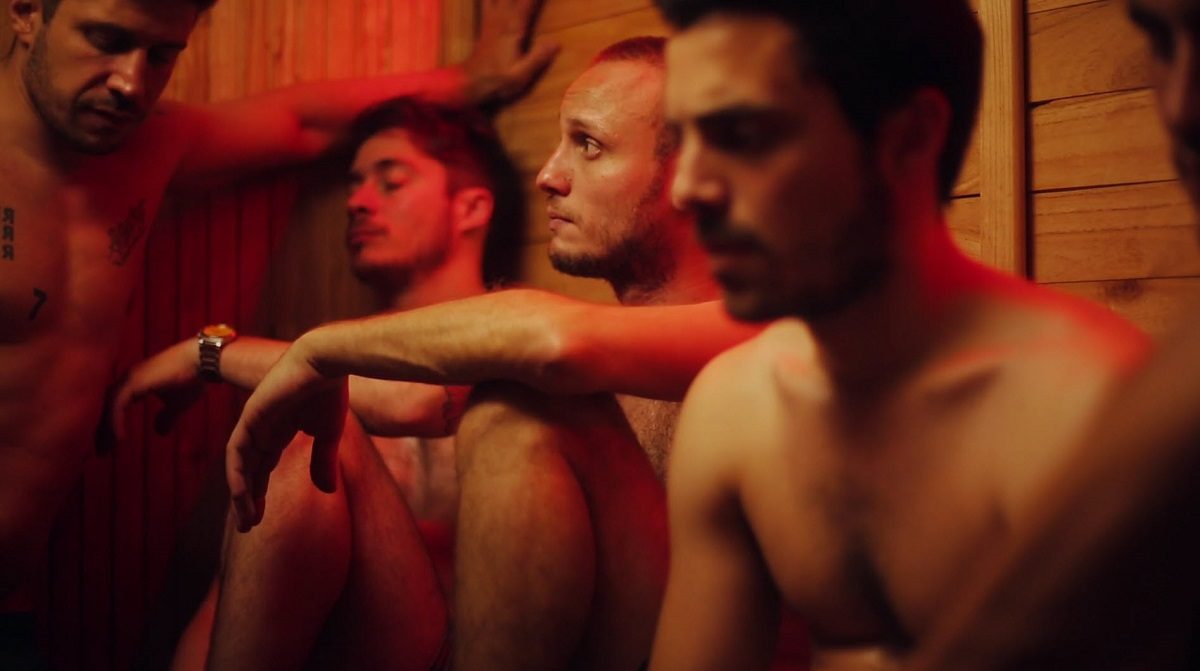
The Argentinean film Taekwondo (Marco Berger & Martin Farina, 2016) takes this sort of gestural observation to erotic extremes, by creating a film that works like a continuously tightening rope of sexual tension and romantic ambiguity, until a final release marks the ending. Like Guadagnino’s film, it is set in a country house during a summer holiday, and often fills shots with half naked male bodies. Specifically, in the scenes set in a steam room, during a point in the story where the audience is only certain that one of the many male characters harbors queer desires, the compositions are particularly effective in highlighting the amount of erotic flesh and skin onscreen as well as its sizzling sensuality to a queer male gaze.
In God’s Own Country (Francis Lee, 2017), there’s a similar, but less obviously tense, dialogue between the viewer and the character’s bodies. Both in starkly frank depictions of post coital intimacy, as well as in the less sexualized domestic scenes, Lee anchors his shots on the dynamic of bodies in relation to each other and the minutia of affective gesture. This way, even without having to constantly use close-ups, the director is able to focus its audience’s attention on touches, on building the growing relationship between his protagonists through the observation of intimacy as expressed in small, otherwise easily negligible details of the actor’s work.
The Ballet of the Gaze
Call Me By Your Name is obsessed with crystalizing the impact of emotional and bodily intimacy, as well as vulnerability. While it’s true a lot of this is achieved through the actors’ clear telegraphing of their character’s interiority, the way such work is shot shouldn’t be dismissed. Regarding close-ups, Guadagnino employs them with admirable economy and precision, allowing some of the film’s most important and prolonged dialogues to play out in carefully choreographed long shots, especially before Elio and Oliver realize and confess their attraction to each other. When they are used, though, these close-ups sometimes make up whole scenes, like the film’s final shot. Call Me By Your Name ends with Timothée Chalamet in close-up, quietly projecting Elio’s explosion of human vulnerability and is almost painful to directly look at. This sort of close-up is partly an uncomfortable confrontation, but also a joyful, almost celebratory demand for the audience’s empathetic investment.
Using close-ups of actors’ faces with slightly overextended durations, allowing the audience to carefully read and perhaps project their own emotional experience onto the actors’ expression, is a formal convention quite popular in recent (post-Brokeback Mountain) queer themed cinema. This produces a sense of intimacy and manifest vulnerability directed at the camera. At the same time, the shots are anchored by the actor’s eyes, thus delineating their look, its direction, intensity and the way the characters perceive their surroundings with their gaze. Generally speaking, these images of desire focused on eyes and looks, when cut together, birth something akin to a ballet of the gaze.
The first lunch between the lovers in Carol (Todd Haynes, 2015) is a perfect example of the phenomenon, with stares, averted glances and pauses for contemplation all presented with a rhythmic structure that’s almost musical. In some of its meal scenes, Call Me By Your Name does away with complex cutting and use of close-ups, but the choreography and careful human observation are still clearly present, almost as much as in Todd Haynes’ period romance. Henry Gamble’s Birthday Party (Stephen Cone, 2015) and Little Men (Ira Sachs, 2016) present other, even less showy kinds of dancing gazes. In both films, the audience must analyze the way the characters look at each other to perceive their interiority, which is possible thanks to the projects’ formal construction, and while Cone does clarify some of the desires at play to the viewer via dialogue, the queerness in Sachs’ film is singularly contained in those never overtly explained gazes.
On the opposite side of the subtlety spectrum, we have Xavier Dolan’s supernovas of cinematic style. In Heartbeats (2010), the act of looking at an object of desire becomes the center of many of the film’s more formalistic exuberant moments. At a party, when the two protagonists sullenly stare at the dancing figure of the man who has enthralled them both, slow-motion, POV shots, and the vitreous look of erotic obsession in the actors’ faces are prelude to the scene’s big visual flourish. Incapable of processing their beloved’s beauty, both characters’ minds flash to works of art, Renaissance sculpture and Jean Cocteau’s drawings, as a way of dealing with the overwhelming nature of their own desire.
Most of Dolan’s other overtly queer themed films also play with the emphasis on his characters’ desiring gazes. This is visible in the nightclub scene featured in I Killed My Mother (2009), in the flashback ending of Laurence Anyways (2012) and in the tense tango of Tom At The Farm (2013), just to name a few instances. Regarding the last example given, it’s worth noting how the two dancers almost never look at each other’s eyes, either in a sign of aggressive provocation or frightful submission. The averted gaze illustrates the intense emotion by highlighting the attempt at keeping one’s vulnerabilities secret. When his characters are alone in intimate compositions, Dolan also tends to show his actors with their eyes downturned, once more defining their vulnerability by denying the audience an easy access to their interiority through the characters’ gazes.
Those downturned looks in Dolan are a rather delicate and solitary variation of the ballet of the gaze we’ve been exploring so far. Call me By Your Name is certainly more aligned with the vulnerable faces of Dolan’s protagonists in close-up rather than with the stylistically explosive illustrations of their desires. Despite his clear investment in the sensorial immersion of his audience, Guadagnino’s approach is one marked by gentleness, when approaching his character’s intimacy, and this affects even the way he shoots the most lustful looks that flash in Elio’s and Oliver’s eyes. Less delicate is the scene in which Yves Saint-Laurent catches the eye of Jacques de Bascher in Saint Laurent (Bertrand Bonello, 2014). Still, this nightclub game of push and pull, is based on the way in which one perceives desire in another’s gaze. The characters’ bodies move through space pulled by each other’s lines of sight and the camera does the same, as if it’s somehow trailing a physical manifestation of invisible desire.
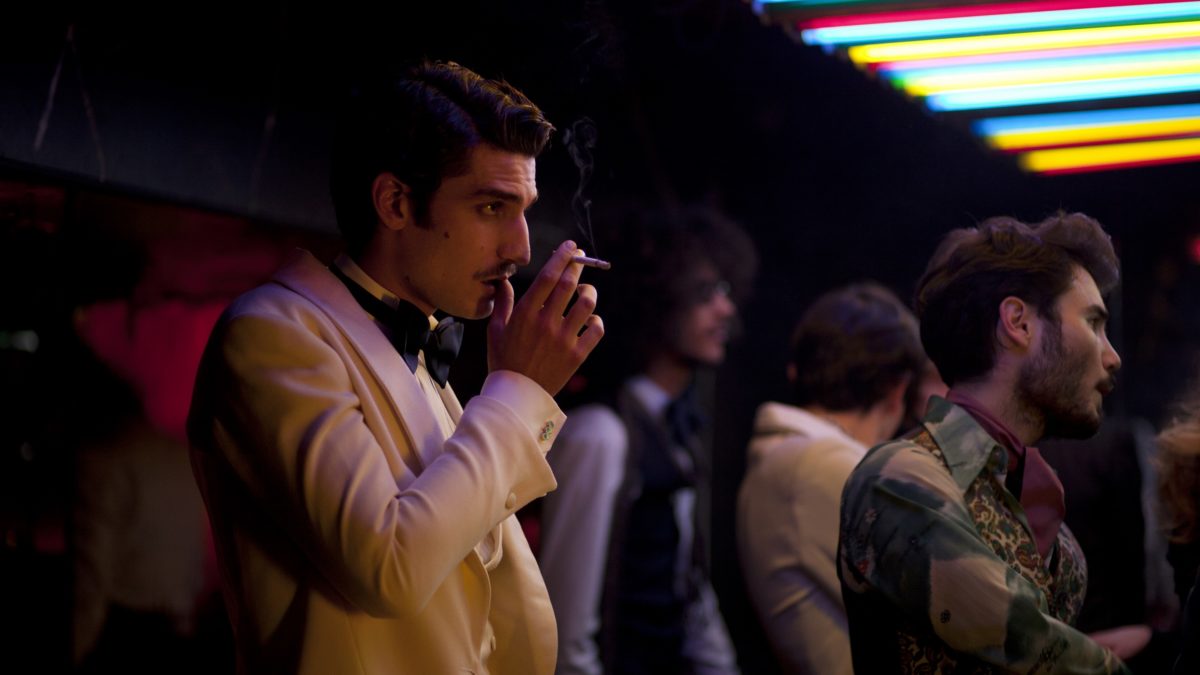
Coded Languages for a Queer Eye
The club setting of that particular moment in Saint Laurent, to say nothing of the fact it’s supposedly happening in the 1960s, does highlight how stares drunk with meaning and codified desire are corner stones of certain aspects of the gay subculture. After all, thinking on the concept of cruising amongst gay males, one realizes the practice is nothing if not a ballet of glances, perceived silent intentions, verbal subterfuge, gesture and iconography as signage of sexual availability. While it’s true such practices as the hanky code have decreased in popularity, their conceptual backbone is still very much present in the gay subculture of today. As part of queer themed art, the films we’ve been exploring are thus informed by that very same culture, where desire is translated in a language that mostly eschews verbality.
Even more influential, in regard to contemporary queer culture, in general, and cinema, in particular, is the dating app hegemony we live in. Grindr, for instance, could be aptly described as the social network answer to the possibilities of cruising in our technological advanced time. Because of that, it’s becoming increasingly difficult for directors of gay films to circumnavigate this reality. As a result, the queer film market is getting increasingly filled by narratives where Grindr or Grindr-esque creations play a major part. Beach Rats (Eliza Hittman, 2017) and Spa Night (Andrew Ahn, 2016) do this, sometimes directly and sometimes by allowing their formal approaches to reflect the apps’ own visual content of bodies made anonymous by fragmentation.
When the young protagonist of Beach Rats plays squash with his friends, flashes of their muscles flexing under skin glistening with perspiration fracture the scene, disruptively and quickly, similar to profile pictures on Grindr but also like quick glances simultaneously lustful, aspirational and terrified. In Spa Night, the protagonist takes numerous pictures of his own body, resulting in images of isolated male anatomy. His self-gaze seems attuned to the sort of imagery commonly found in the previously mentioned apps, and the scrutiny of his own body reflects the reality of online communities obsessed with straight acting muscular ideals of queer masculinity. Furthermore, when travelling through the steamy inside of a Korean spa used by gay men as a cruising spot, Ahn’s camera presents the audience with collections of fleshy compositions filled with naked knees, sweaty shoulders and sensuous shapes barely hidden under robes and towels. These compositions break bodies into erotic fragments, illustrating the terrified, but excited POV of the film’s protagonist, as well as the bodily iconography of a subsection of the modern world’s gay community.
In 1983, when Call Me By Your Name takes place, the hanky code was still popular, at least in the leather scene, but dating apps were decades of technological development away. That could be one of the reasons why the film seems to avoid the body fragmentation and graphic depiction of male nudity so easily associated with Grindr and its brethren. Another, more enlightening and plausible justification for this stylistic choice is found when exploring the dynamic established between explicitness and emotional intimacy within the realm of queer themed cinema and how that specifically affects Guadagnino’s film.
Showing, Hiding, Suggesting Sex
Grindr plays a major role in 4 Days in France (Jérôme Reybaud, 2016), the story of two gay men playing a game of cat and mouse through the French countryside, both aided in their efforts by the app. One of the men is escaping, wandering aimlessly in search of anonymous sex. The other is looking for his partner by using the same mechanism, only his target isn’t at all anonymous to him. Considering such a plot description, it would be easy to presume that this, more than most other recent titles of queer cinema, would be an explosive example of fragmented bodies, emulating the profile pictures of enticing abs and the often-shared dick pics. In reality, this is a film almost completely devoid of explicit nudity or long, detailed sex scenes. As a matter of fact, the most prolonged moment of sexual activity, which is visualized in vaguely theatrical fixed symmetrical compositions, is the moment when two men masturbate separated by a wall. Their hands are stretching over the barrier as if trying to feel the other, their non-verbal moans their only form of communication. By denying direct sexual copulation, Reybaud has managed to crystalize his characters’ longing, one that transcends bodily needs.
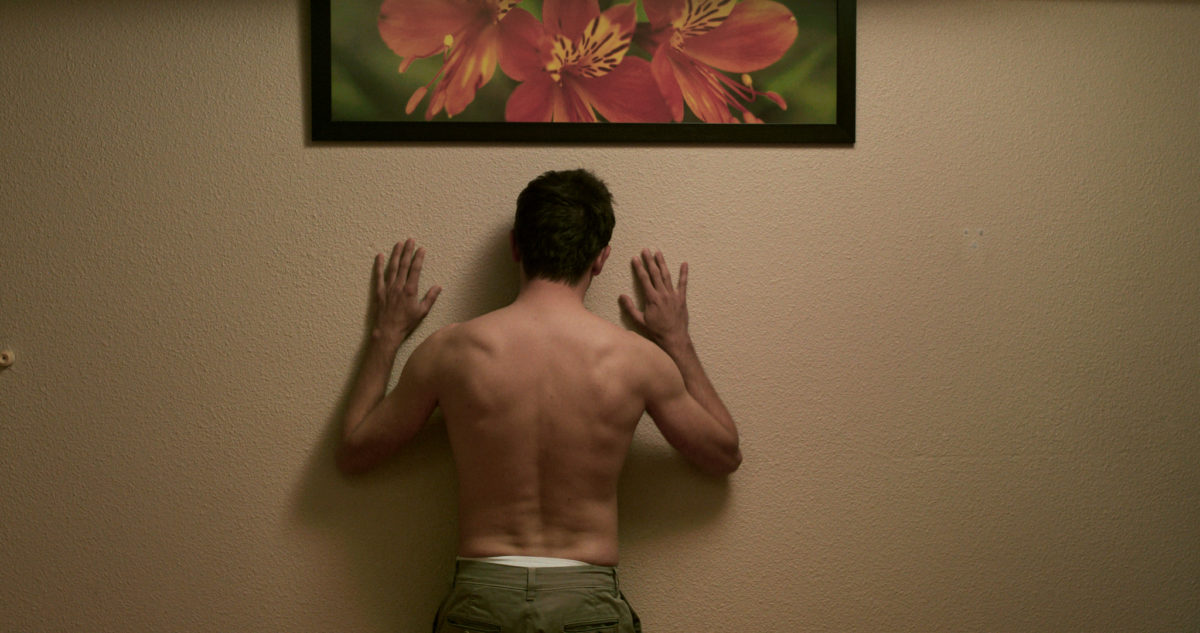
Compared with the pornographic explicitness of films like Stranger by the Lake (Alain Giraudie, 2013), 4 Days in France becomes a beguiling guide to how, in queer cinema, desire is often, but not always, prioritized as an intrinsic part of human connection, while graphic depictions of sexual contact tend to be more about individual pleasure. In Giraudie’s thriller set in a cruising spot by a lake, the explicitly shown sexual activity is part of the mundane, repetitive rhythms of solitary life experienced by most of the film’s human figures, lonely men looking for interpersonal connection and physical fulfillment. The latter doesn’t guarantee the former, though, and that is made clear both by the rigid formal construction and by the way in which the occurrence of murder is less startling to the film’s tone and thematic coherence than a mysterious, perhaps asexual, bond formed during casual conversations between a lean handsome gay man and an older gentleman calling himself straight.
Another queer themed film that generously uses non-simulated sex scenes shown in pornographic detail is Shortbus (John Cameron Mitchell, 2006). While sex is an intrinsic part of every human relationship portrayed in this narrative, a fact that is celebrated and never shown as shameful or in need of being hidden, it’s worth mentioning how the film’s sex scenes are progressively less graphic as its 101 minutes unfold. The director frontloads the more “shocking” material, trying to strip away what makes it shocking, thus allowing his audience to be familiar with the graphic register to, later on, be focused on the emotional turmoil of his characters and not solely on their eroticized bodies.
By structuring Shortbus to become less explicit as it goes along, Mitchell doesn’t deny the importance of sex in his character’s world, he merely highlights how those sexual activities have more to them than the immediate pleasure of the individual. This dynamic could very well be used as a way of justifying the differences between the straight and queer sex scenes in Call Me By Your Name. After all, Guadagnino could be averting his gaze from the queer sex in order to preserve the tangible cinematic presence of emotional intimacy, respecting his characters while avoiding voyeurism and placing the moment in the nostalgic bliss of a cherished memory, delicately playing out before the audience.
Still regarding the dynamic between sexual explicitness and emotional intimacy, the sex scenes featured in BPM (Robin Campillo, 2017) are a pertinent object of study. Several writers, including Kevin O’Keefe for the queer magazine Into and Billy Gray for Slate, have used the film as a counter example to Guadagnino’s supposedly coy representation of queer sex and desire. While it’s true that the French film about queer activists during the AIDS crisis features a sex scene which suggests much more specific actions than Call Me By Your Name, male frontal nudity is absent from both films. BPM is more explicit, but not by much, and that lack of graphicness seems to be directly correlated to the way the film uses sex as an action that signifies much more than individual physical gratification.
In Campillo’s film, sex is a way of creating intimate interpersonal connections, a way of dealing with grief and, perhaps more importantly, a bodily manifestation of a political discourse. The director thus highlights how the body is political and how the existence of a queer individual in society is a politicized action unto itself. While trying to defend any work of art as apolitical is a fool’s errand, Call Me By Your Name is a film clearly uninterested in exploring its characters’ desires and sex lives as anything more than as specific emotional and sensual experiences, eschewing the overt political discourse of BPM. That doesn’t mean, however, that the French film is more intrinsically queer than Guadagnino’s project, neither in content or in the way it formally illustrates the intimacy of its queer characters.
Shared Clothes, a Shared Bed
Because of queer sexualities’ place outside the standardized concepts of social normalcy, queer films seem almost obligated to acknowledge their characters’ desires in ways subtly different to their heteronormative counterparts. In straight love stories of the big screen, sexual desire’s usually put aside when representing romantic attraction, even once sexual activity is shown. This is not to say such representations of romance are intrinsically inferior to sexually charged queer ones, they’re just different and use other sets of iconographies as well as their own formal conventions.
Take, for instance, the image of someone wearing their lover’s clothes. This is a reality that certainly isn’t exclusive to same sex relationships, but tends to possess an almost talismanic power when manifested in cinematic representations of gay romance as opposed to a cute little afterthought in straight love stories. The most obvious example of swapped pieces of clothing being imbued with symbolic power in queer themed films is, of course, Brokeback Mountain’s last scene. In it, two shirts hung together become a heartbreaking visualization of a romantic union that, for a myriad of personal and social reasons, couldn’t be lived in an open, longstanding manner and which death put an abrupt end to.
Far away from Brokeback Mountain’s tragic outcomes – a sad mainstay of queer themed cinema until very recently – God’s Own Country features a red jumper that, throughout the narrative, becomes a symbol of the intimacy shared between its two romantic leads. When one of them leaves the other before the film’s last act, his jumper remains, signaling the lost intimacy of being close to another human being. What’s important to take note of here is how that jumper represents an intimacy that isn’t only emotional but also erotic since the very act of putting on the clothes of one’s lover is reminiscent of sex, of nudity, of the touching of skin. Even more sexual is the swapping of clothes in Call Me By Your Name. In this instance, it’s a billowy shirt, once used to clean sperm off Oliver’s chest, that Elio keeps for himself as a token of the love that bloomed in that idyllic summer. The cinematic queerness of this action comes from the way in which romantic attachment is declaratively weaved with sexual desire.
Another shot often repeated in queer themed films and present in Call Me By Your Name is that of two lovers lying in bed, the camera above them, their faces turned to each other, perceived in profile by the viewer. This image is also present in depictions of heterosexual romance, though those stories rarely use it like their queer counterparts do, as the climatic peak on a narrative of growing emotional and physical intimacy. Weekend (Andrew Haigh, 2011) features a scene built around such an image and it could be accurately described as the emotional centerpiece of the narrative, a moment of peace caught between sexual activity, when two men are open to the other in ways they may have never been able to experience with another human before.
The horror adjacent Rift (Erlingur Thoroddsen, 2017) uses the same image as a prelude for sexual activity, but a dialogue where two men show emotional vulnerability, previously unknown even to themselves, is still present. The post-coital contentment of the afterglow isn’t a necessary aspect of these scenes, but the image of two lovers in bed does reflect a kind of intimacy that is impossible to disassociate from sexual union. This brings us back to Guadagnino’s film, in which the image appears while sex is very much in the air. Even so, the immaterial mutual desire is even more present than the act of consummation itself, especially when considering the overwhelming closeness illustrated in Oliver’s gesture of touching Elio’s face and in his simple request: “Call me by your name and I’ll call you by mine.”
Drowning in Emotion, Sensually Isolated
The swapping of clothes and the act of lying in bed with a romantic partner are not necessarily queer or straight, but there are some formal mechanisms and pieces of filmic iconography that do feel somewhat more exclusive to a specific sexuality. West Side Story (Jerome Robbins & Robert Wise, 1961) features a good example of a mechanism, made iconic by this musical and originated in depictions of exclusively straight romance, that has been appropriated and altered for queer sensibilities. A man and a woman, both from antagonistic social factions, are visually and aurally separated from their surroundings. As the world that will undoubtedly object to their love vanishes in the darkness and is muted by a wall of psychological sonic isolation, the future lovers can gaze at each other and the audience can gaze at their gaze.
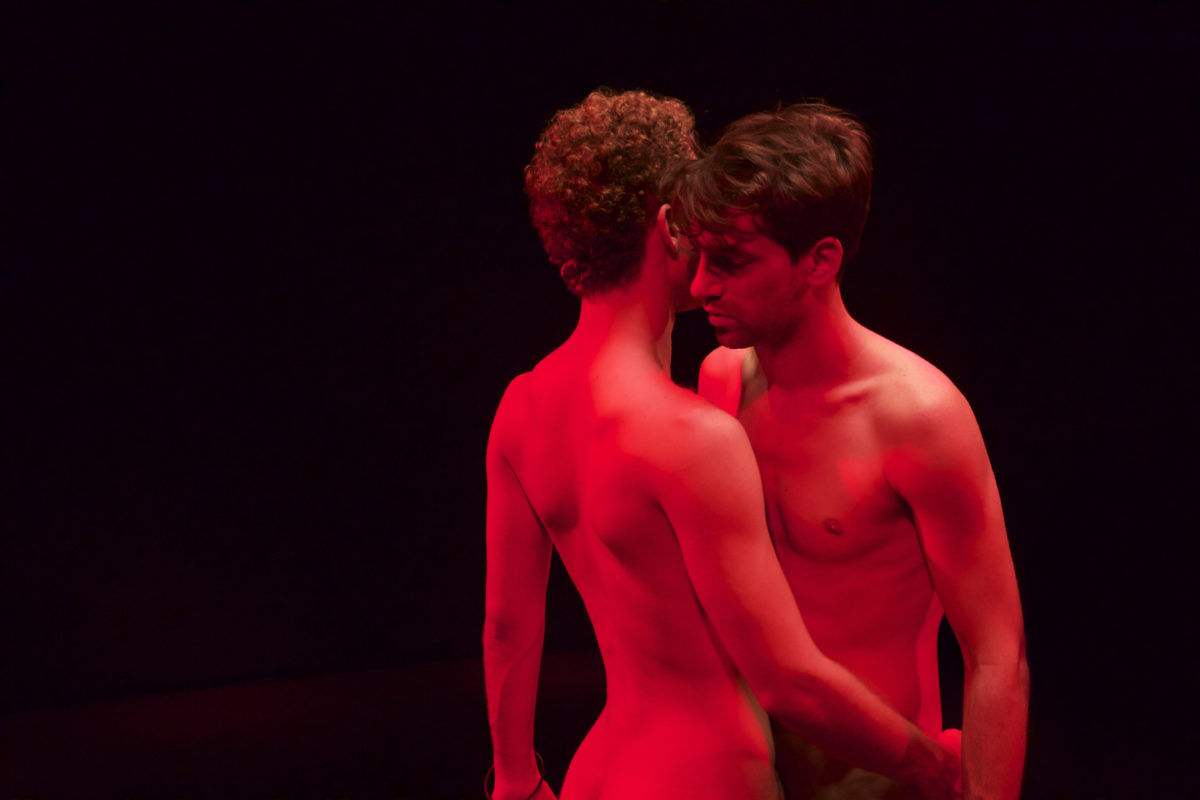
Olivier Ducastel & Jacques Martineau, 2016)
In Paris 05:59 (Olivier Ducastel & Jacques Martineau, 2016), West Side Story’s representation of instantaneous mutual attraction is evoked, though obviously reimagined for a new universe of queer desire. Somewhere in Paris, a gay club is hosting an orgy in its lower floors, where the two title characters meet. Despite their otherworldly isolating connection not being immediate, the scene’s climax happens when the landscape of copulating bodies is pushed to the periphery and the two find themselves hermetically sealed in a reality of their own, like West Side Story’s Maria and Tony once were. This time, however, the consummation of their attraction isn’t a symbolic dance. In fact, it’s a non-simulated sex scene under a spotlight.
We can also find this sort of audiovisual isolation as indicative of queer desire outside the realm of European art cinema. Battle of the Sexes (Jonathan Dayton & Valerie Faris, 2017) is a mainstream piece of American biographical filmmaking, but it has a queer protagonist and a fair share of its emotional weight comes in the subplot of Billie Jean King’s romantic entanglement with a female hairdresser. Their first encounter is one charged with erotic possibility flowering in a socially repressive atmosphere, and what is initially a scene dominated by casual chat and ensemble interaction is slowly morphed into a suggestive verbal pas de deux. The textual component is unnecessary though, considering how close-ups and judicious editing erase the space around the two women, the way their crossing glances demand attention and how the soundscape disintegrates until we’re left with the seductively soothing quality of Andrea Riseborough’s voice. As a code of queer desire, this captures the essence of the moment and is enough to telegraph the characters’ budding attraction.
Queer characters being formally isolated from their surroundings isn’t something that happens only in the context of romance or mutual attraction. After all, being queer in our heteronormative society is an isolating factor by itself. In ways that straight people never have to, queer people are almost forced to contend with their own desires and identities, to question themselves and examine their innermost impulses and wants. Consider the protagonist of Pariah (Ree Dees, 2011) alone on the bus, the outside a blur of bright colors bleeding together like nocturnal watercolors. Consider one of the first shots of Tomboy (Céline Sciamma, 2011) and its use of shallow depth of focus to make the lead character float over a background of undefined greenery dappled with sunlight. Consider the lonely bus rides of Xavier Dolan’s protagonists in I Killed My Mother and Laurence Anyways, their worlds going out of focus to accommodate the depths of their melancholy.
Call Me By Your Name never features such a moment or image. If anything, Guadagnino is invested in situating Elio and Oliver’s summer romance in a very specific place, both in terms of geography and culture. Even at his most vulnerable and fragile state, Elio is framed in a way that calls attention to the architecture and flora surrounding him, to the people passing by on the periphery of his personal turmoil. Jean Renoir’s Partie de Campagne (A Day in the Country, 1936), with its bucolic visions of love blossoming in the countryside, was one of Call Me By Your Name’s principal cinematic reference points and that shows in those images of an Italian idyllic summer happening around the characters. One could even go so far as to relate the camera movement from the lovers to the window, during the gay sex scene, to Renoir’s many shots of windows, not to mention his use of them as a metaphor for more moral and theoretical explorations. That said, a more complete and invested reflection on the influence of Renoir in Guadagnino’s cinema, not just Call Me By Your Name, could perhaps take us too far away from the theme at hand, the representation of queer desire.
In fact, when reflecting further upon the legacy of queer cinema, the way in which those shots, full of peripheral natural life and warmth, illustrate the film’s relative lack of societal pressure weighing down on the two queer lovers is more refreshing and relevant than Renoir’s influence. Natural landscapes offer a similar sort of erotic isolation from societal pressures in other queer themed films such as Moonlight with its beach scene, God’s Own Country and the Yorkshire countryside and Brokeback Mountain with the lonely splendor of the Wyoming mountains. Such an absence of open anti-queer hostility is also something that could almost be characterized as novel, especially when one remembers that we can’t even categorize Call Me By Your Name as a coming out story. This doesn’t mean that Guadagnino is forsaking a specific queer discourse or separating himself from the legacy and tradition established by the previously mentioned films.
Queer Desire Exploding into Abstraction
Despite their selective erasure of surrounding contextual elements, neither Paris 05:59, Battle of the Sexes, Pariah or Tomboy do away with the tangible representation of material reality, but that’s not always the case with queer cinema. Sometimes, to better represent the electrifying quality of sexual and romantic desire melting into each other, filmmakers abandon pictorial illustration. Carol, Beach Rats and Call Me By Your Name all feature this dynamic. A moment of explosive desire seems to force these films into momentary reveries of audiovisual abstraction.
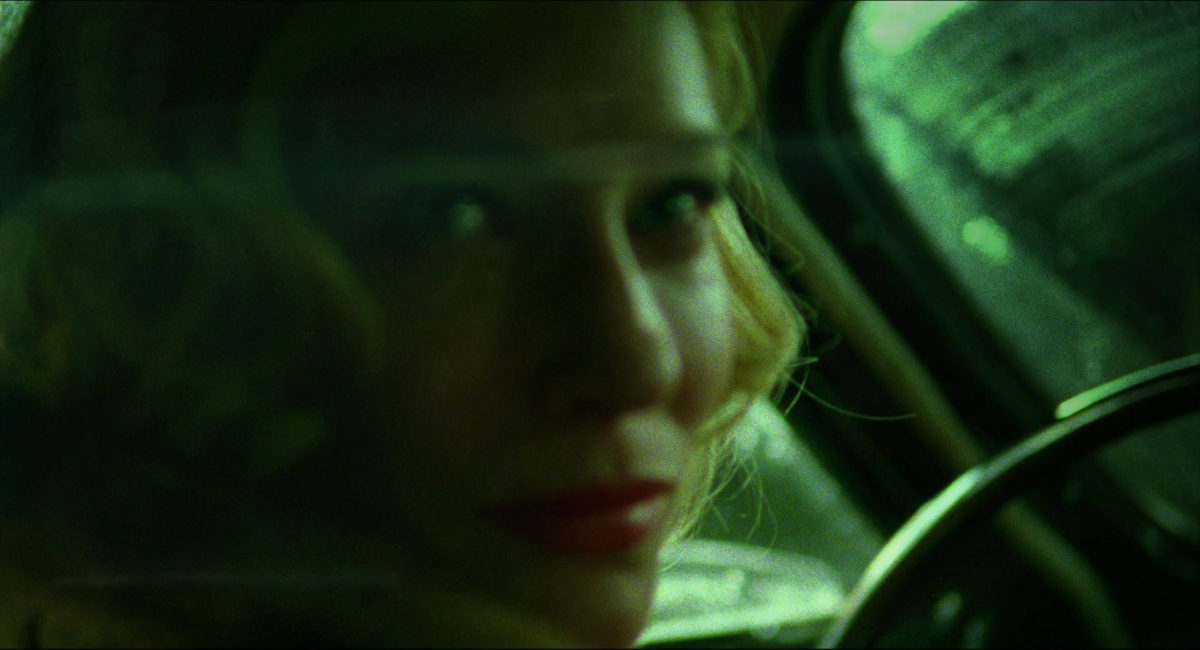
When the desire being filtered through Carol’s audiovisual construction becomes too much to bear, too complex for the celluloid to hold it, the film seems to explode, or rather to fragment itself. Carter Burwell’s score, for example, breaks apart its main motifs, changing its tempos and substituting the complexity of strings for the amorphous eeriness of refracted human voices. Ed Lachman’s cinematography does something similar, obsessively caressing Carol’s clothes, hair and face before going out of focus as if her beauty is impossible to contain or adequately document. This transcends pictorial illustration of the optics of desire, it’s overwhelming passion burned into 16mm film.
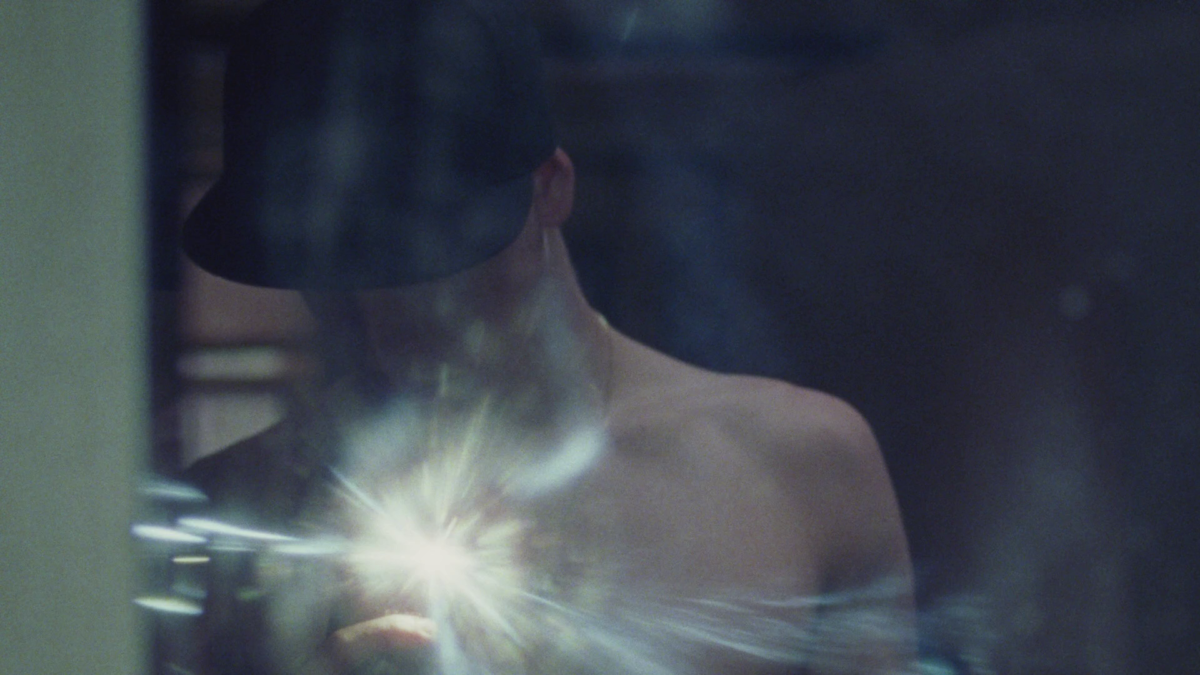
In Beach Rats, such instances of deliberate visual non-definition come in bursts, like the colorful firework symbolism the film is obsessed with. Whenever the story’s protagonist initiates a sexual encounter with another man, the subjective formal approach organically gives itself to abstraction. When the want of carnal connection is fulfilled, instead of graphically documenting the sexual act, the director lets the emotional experience of her subject dictate the way the audience gets to perceive him.
In Call Me By Your Name, Guadagnino also sometimes forgoes a perfectly focused shot, letting the emotions on screen blast through even that technical standard. The feelings of the characters are deemed more crucial to the overall filmic object than the relatively objective perception of physical existence. Admitting the impossibility of visualizing such emotional realities becomes more important than the feeble attempts at solving that very same impossibility.
The Queerness of Looking Away
As a barometer of artistic quality, the Oscars are rather useless. This isn’t to say they are otherwise obsolete, for these awards influence many aspects of cinema, especially distribution and availability, and represent a fascinating reflection and sample of what is considered respectable, good, worthy of praise and celebration at a certain point in time. In part, that’s why this institution’s systematic failure regarding the presentation of a socially progressive attitude can be so troubling and representative of bigger issues outside of the matter of who gets to have their name engraved on the base of a little golden man’s statuette.
Before Brokeback Mountain was nominated for the Best Picture Oscar, the most recent nominee to feature a considerably visible and unambiguous queer storyline or character was The Hours (Stephen Daldry, 2002). In that film, several queer women are presented on screen, but their sexual desires are mostly ignored, especially in the film’s formal discourse, which presents at least one of three same sex kisses as something startling, almost frightening in its predatory physicality. The narrative also features two gay men, one a glorified cameo for its actor, another a tragic figure that garnered Ed Harris his fourth Oscar nomination. The character, an AIDS stricken dying, desexualized, suicidal gay man who dies by the end of the film, is a familiar figure to whomever has ever tried to explore representations of queer lives in mainstream and mainstream-adjacent cinema of the 20th century.
Tragic colorful characters, dying for their sins, rendered in a way that erases any sort of sexual desire that might exist within them were once the norm of queer themed films, unless one looked at the film festival circuit or was lucky or judicious enough to come upon a rare exception to the rule. Brokeback Mountain does end tragically, but its characters don’t completely fit this mold and, more importantly, their desires, their queerness, is present both in their actions and attitudes as well as in the way the film itself is constructed. In one shot, for example, Ang Lee frames Jake Gyllenhaal in the foreground, while, in the background, Heath Ledger washes his naked body out of focus. Gyllenhaal’s downturned eyes and tense posture, along with the suggestive framing, create an illustration of queer desire being willfully repressed, or at least contained. By representing the act of hiding one’s desires, of avoiding a lustful stare, Ang Lee made those desires explicitly manifest to his film’s audience.
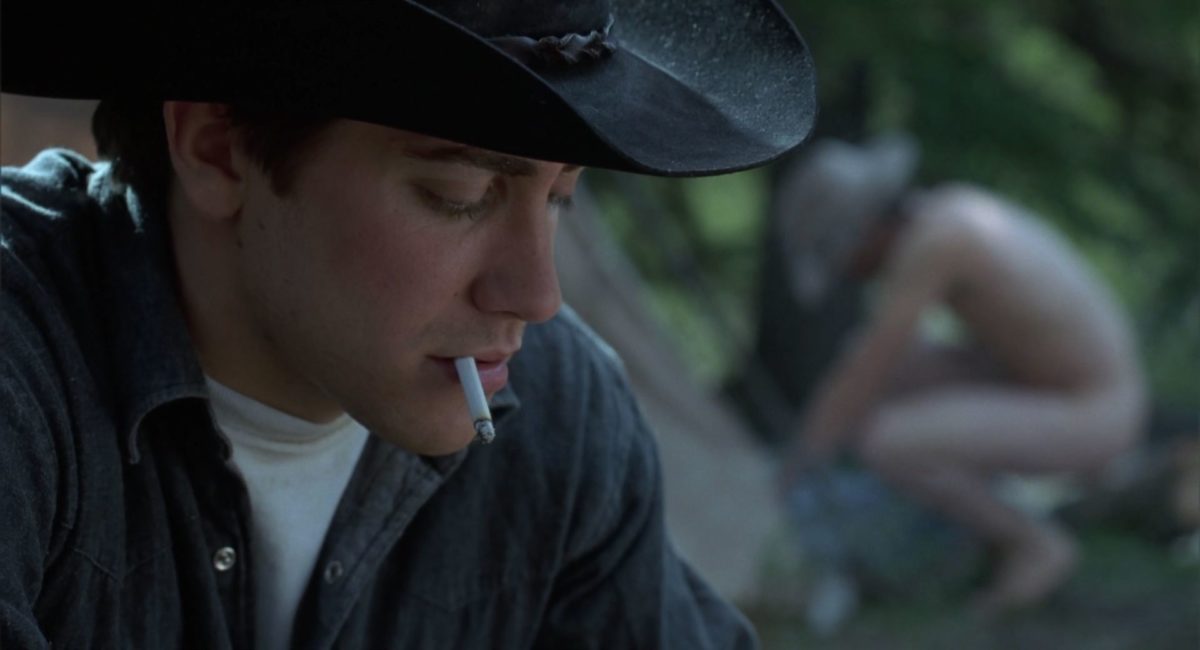
More than a decade later, after a noticeable inching of queer themed cinema into the mainstream and a subsequent flock of other vaguely queer themed films making it into the list of Best Picture Oscar nominations, God’s Own Country features an almost exact reproduction of that shot in Brokeback Mountain – a man in the foreground pointedly not looking at another man washing his naked body in the blurry background. This time around, however, there is no tragic ending. Moreover, this representation of queer desire through the showing of characters averting a lustful gaze from their object of affection is something close to a convention of contemporary queer themed cinema, part of a wider discourse that is made manifest and developed by repetition among numerous examples of similarly themed projects.

This essay identified some of the conventions of today’s queer cinema: great attention paid to character’s gazes and body language in close-ups and master shots dominated by said bodies; visually fragmented erogenous zones; the appearance of dating apps; the cinematic dynamic between sexual explicitness and emotional closeness; shared clothes and beds as talismans of intimacy; visually and aurally isolated lovers; queer individuals travelling alone through out of focus worlds and instances of queer desire making the very fabric of cinematic materiality dissolve into abstraction. This is a set of mechanisms, norms, gestures that are used by a widespread array of filmmakers as cinematic codes of representing specifically queer desire, sexuality and identity.
Like God’s Own Country, Call Me By Your Name is being released into a post-Moonlight world. It’s being commercially released and promoted as an awards frontrunner, as a prestige picture that every cinephile worth their salt should watch, in a world where the most recent Best Picture Oscar winner was about the life of a queer African-American man, who once received a hand job from his best friend on a Miami beach and whose desires are often illustrated through shots laser focused on the character’s eyes perceiving the world around him, his own reflection and those he loves and wants. As it happened with Moonlight, many are describing Call Me By Your Name as “universal”, implying an apology for or a dismissal of its queerness.
Luca Guadagnino himself may follow the party line by saying that Call Me By Your Name shows a concerted effort to find universality in its love story, but the way he chose to shoot and present said story is in keeping with a specific queer discourse that was outlined here– it’s not universal. That vaguely sloppy pan to the right during the first sexual encounter between Elio and Oliver could have been more elegantly integrated in the scene itself as well as in the film’s overall construction, but its usage is not an erasure of the story’s queer specificity nor a coy compromise. If anything, it’s a reinforcement of that very queerness, when a more explicit approach might have felt like a betrayal towards the characters and the essential emotional truth of the moment within the love story.
To avert one’s eye from something that’s too alluring to be directly confronted, or from someone too precious to be alienated is, as been established with many examples, a basilar stone in the building of contemporary queer cinema’s stylistic language. In Call Me By Your Name, Elio may spend minutes staring at Oliver dancing, but when he joins him at the dance floor, when he actually enters the stage of social interaction, he never once looks at the object of his desire. When the couple is about to have sex for the first time, the camera also looks away. The shots are very different from those in the dance scene, but the gesture emulates Elio’s averted gaze. Thus, the emotional power and even the sensuality of the moment isn’t defined by a graphic representation of intercourse, but by withholding one’s gaze, by looking away in a gesture of beautiful cinematic queerness.
